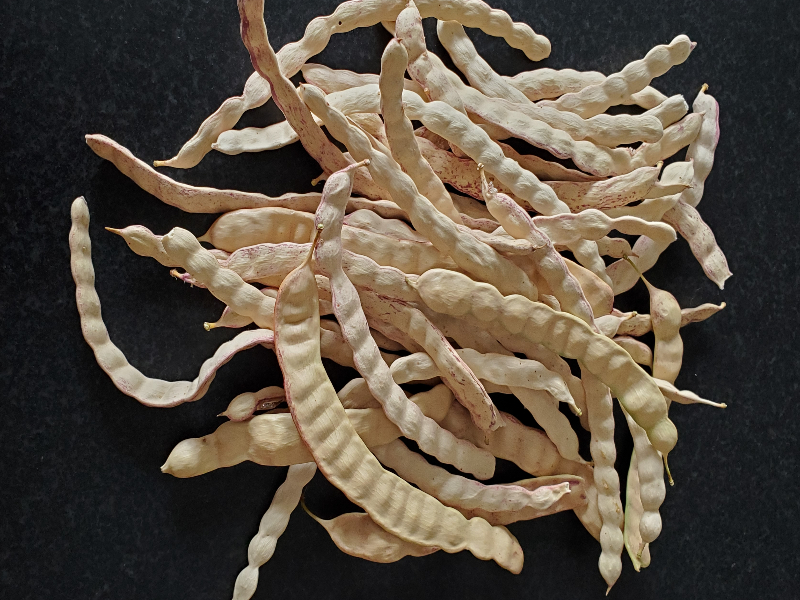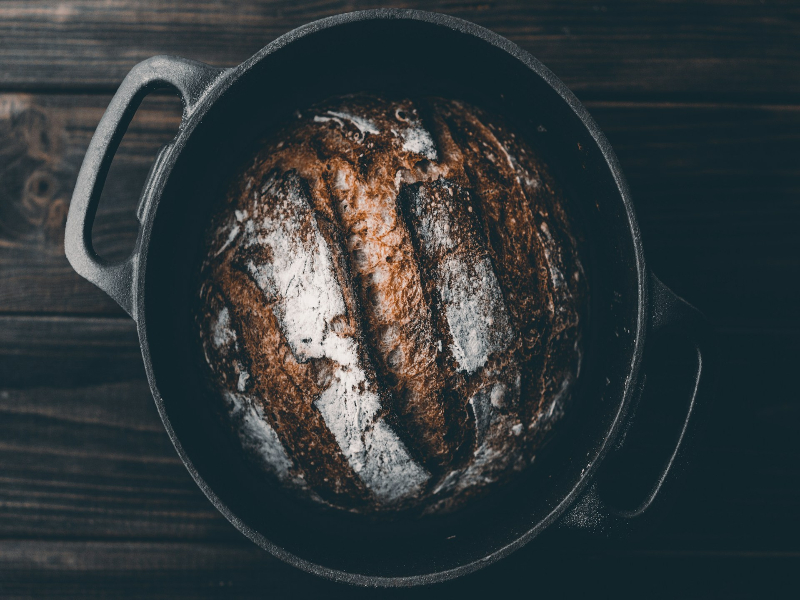
Wihog – Mesquite Bean Pods
Since last week was all about Palo Verde beans it seems like a natural segue to talk about the other mainstay leguminous tree in our Sonoran Desert – mesquite.
The three mule deer who are part-time residents at my house may or may not eat mesquite pods, but they sure love to seek respite from the sun and heat under the giant tree in my front yard.
I’ve learned so much about mesquite and the amazing foods (and whiskey) to make with it from these incredibly talented people: Gallery of Food owner/Chef Kristine Jensen (date and mesquite bars are the dessert in her Tuesday class); Shirley Molina of the Schuchulig Village on the Tohono Nation; cookbook author/writer Carolyn Niethammer; Whiskey Del Bac’s Stephen Paul (who designed and made mesquite furniture for years); and Zio Peppe co-owner/Chef Devon Sanner. Although I never met Sandal English, the Arizona Daily Star food editor from 1969-1985, I count her as a teacher since her 1981 cookbook, “Fruits of the Desert,” is a frequent resource.
Wihog is the Tohono O’odham word for mesquite bean pods. For 4,000 years the tree has provided food, shelter, medicine and fuel.
When harvesting pods, I eat some as a snack right off the tree, chewing and sucking for its sweet juice. It’s a good way to test its sweetness since while all mesquite varieties produce pods, not all are sweet.
Remember the cardinal rule: Only pods still on the tree. None once they hit the ground. Those can get damp and have mold or bugs.
In the traditional way, elders use a special grinding stone to make mesquite flour. The stone (cepidakud in the native language) is long and narrow. Pods go in a hole in a larger stone and the cepidakud grinds them into flour.
With the second flowering season in August or September, there will be plenty of time for a fall harvest. Green pods will form soon after the flowers appear and about a month later the pods will start to ripen and dry. By October, they should be ready. If picking green pods, be sure to place them on paper or cloth, before laying on the ground to dry in the sun.
How to clean pods: Remove all pointy stems from the ends and any attached leaves or branches. Brush off dirt or bugs. Throw away pods with black spots – it’s mold and will ruin your batch.
All pods contain a bruchid beetle that lays its eggs in the pods. To prevent the eggs from hatching, dry them in the sun for at least a week before storing, place them on a baking sheet in a 350°F oven for five minutes, microwave on high two-three minutes or put in a bag and freeze overnight. Dried pods will keep indefinitely.
Classes
Give Slow Food Southern Arizona President and Certified Executive Chef Barry Infuso 60 minutes on July 22, yes, in an hour you’ll lunch and learn an Asian inspired menu: Artic char packed with omega-3 fatty acids, B vitamins, potassium and selenium; baby bok choy, the vitamin-rich Chinese cabbage; rice; and for a sweet ending, Chinese almond cookies and tea.
Chef Dee Buizer’s July 26 Exploring Thai Cuisine class is sold out. Thank you to everyone who registered.
On July 27, you’ll explore five craft beers in Borderlands Brewing Co. Head Brewer Ayla Kapahi’s class. You’ll enjoy Viejo Pueblo Blonde Ale – brewed with local Tohono O’odham corn; Prickly Pear Wheat – an easy-drinking German-American wheat beer with local organic prickly pear juice adding beautiful flavor and color; Ayla’s choice of IPA; Noche Dulce Vanilla Porter – aromatic, slightly sweet with notes of coffee and dark chocolate with Mexican vanilla beans giving it aroma and taste; and Citrana German-style Gose Sour – tart and refreshing!
Wishing you joy in the kitchen,
Michele
Wihog Wadagi – Mesquite Juice
Yield: About 8 cups
This drink is refreshing on its own. It can be boiled down to make syrup.
4 cups mesquite pods
10 cups water
1. Remove stems and leaves from pods and discard any moldy ones.
2. Add pods and water to a large pot; bring to a boil then cover and simmer 1-2 hours until pods are very soft. Cool.
3. Place pods and water in a large bowl using fingers, rub and squeeze until they’re stringy and seeds separate from pods, swirling in water to remove as much pulp as possible.
4. Pour through a fine mesh strainer set over a separate bowl or bucket, pushing to extract as much juice as possible. Discard pulp and seeds.
5. Taste. If too sweet, add additional water a little at a time. Juice will separate as it sits; stir or shake before drinking.
6. Fresh juice keeps up to 1 week in refrigerator; up to 1 year frozen in jars, plastic containers or ice cube trays.
Mesquite Syrup
Yield: ½ cup
4 cups mesquite juice
Water, if needed
1. Bring juice to a boil over high heat then reduce heat to medium and simmer about 1 hour until it thickens and coats the back of a spoon. The consistency should be like maple syrup.
2. If juice has a lot of pulp, strain before cooking since it may become very thick when cooked. If it becomes too thick, add ½ cup water at a time to thin it out. It will thicken as it cools.





